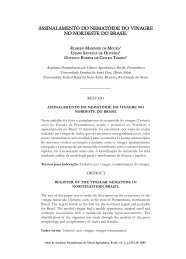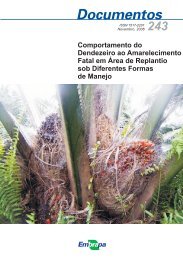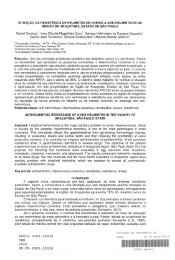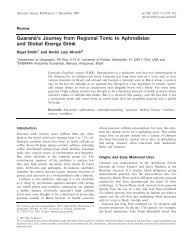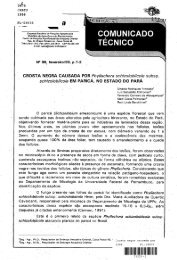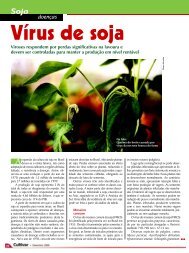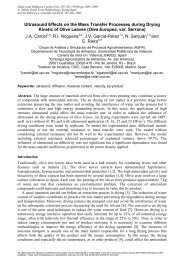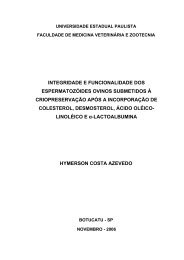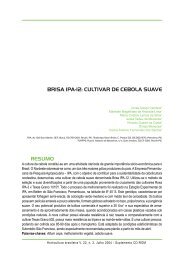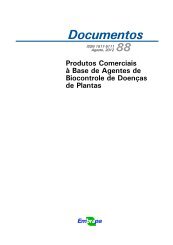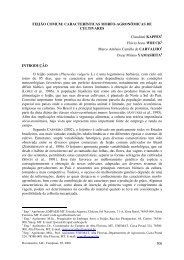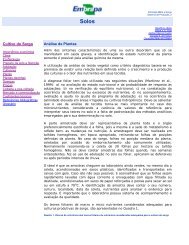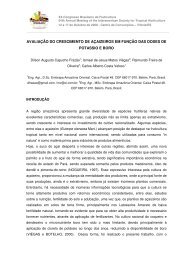Milk-clotting activity of enzyme extracts from ... - Ainfo - Embrapa
Milk-clotting activity of enzyme extracts from ... - Ainfo - Embrapa
Milk-clotting activity of enzyme extracts from ... - Ainfo - Embrapa
You also want an ePaper? Increase the reach of your titles
YUMPU automatically turns print PDFs into web optimized ePapers that Google loves.
International Dairy Journal 17 (2007) 816–825<br />
<strong>Milk</strong>-<strong>clotting</strong> <strong>activity</strong> <strong>of</strong> <strong>enzyme</strong> <strong>extracts</strong> <strong>from</strong> sunflower and albizia<br />
seeds and specific hydrolysis <strong>of</strong> bovine k-casein<br />
Abstract<br />
A.S. Egito a , J.-M. Girardet c , L.E. Laguna a , C. Poirson c , D. Molle´ b , L. Miclo c ,<br />
G. Humbert c , J.-L. Gaillard c,<br />
a Laboratório de Tecnologia de Leite, <strong>Embrapa</strong> Caprinos, Estrada Sobral-Groaíras, Km 04—Fazenda Três Lagoas—Caixa postal D-10,<br />
CEP 62011970, Sobral, Ceará, Brazil<br />
b Laboratoire de Science et Technologie du Lait et de l’Œuf, Institut National de la Recherche Agronomique,<br />
65 rue de Saint Brieuc, 35042 Rennes Cedex, France<br />
c Unité de Recherche sur l’Animal et Fonctionnalités des Produits Animaux (URAFPA), Nancy-Université, U.C. INRA 340,<br />
Faculté des Sciences et Techniques, UHP-Nancy 1, B.P. 239, 54506 Vandœuvre-lès-Nancy Cedex, France<br />
Received 22 May 2006; accepted 26 September 2006<br />
<strong>Milk</strong>-<strong>clotting</strong> <strong>activity</strong> found in ammonium sulfate-precipitated protein <strong>extracts</strong> <strong>from</strong> Albizia lebbeck and Helianthus annuus seeds was<br />
studied. Specific <strong>clotting</strong> <strong>activity</strong> <strong>of</strong> albizia seed extract was 15 times higher than that <strong>of</strong> sunflower seed extract. Zymogram analysis<br />
revealed several proteolytic bands in albizia seed extract and one diffuse proteolytic band for sunflower seed extract. Whole bovine casein<br />
was incubated with the plant seed <strong>extracts</strong> or chymosin and some breakdown products were characterized by reversed-phase highperformance<br />
liquid chromatography and electrophoresis. Similar to chymosin, the two seed <strong>extracts</strong> exhibited proteolytic <strong>activity</strong> toward<br />
k-casein, as-casein and b-casein, with the highest <strong>activity</strong> observed for the albizia seed extract. Mass spectrometry analysis showed<br />
that the sunflower extract hydrolyzed k-casein at the Phe 105–Met 106 bond, as does chymosin. The albizia extract also displayed <strong>activity</strong><br />
on k-casein, but the Lys116–Thr117 bond was its preferred target.<br />
r 2006 Elsevier Ltd. All rights reserved.<br />
Keywords: Plant rennet; <strong>Milk</strong>-<strong>clotting</strong> <strong>activity</strong>; Bovine casein; k-casein; Albizia; Sunflower<br />
1. Introduction<br />
Among the vast number <strong>of</strong> proteases with applications in<br />
the food industry, aspartic proteases such as chymosin (EC<br />
3.4.23.4) are used for milk <strong>clotting</strong> in cheese-making. The<br />
primary cleavage occurs at Phe105–Met106 bond <strong>of</strong> bovine<br />
k-casein (k-CN; Jolle` s, Alais, & Jolle` s, 1963) and causes<br />
destabilization <strong>of</strong> the casein micelles, resulting in milk<br />
coagulation to form the cheese curd.<br />
<strong>Milk</strong> <strong>clotting</strong> can be achieved by a number <strong>of</strong> proteolytic<br />
<strong>enzyme</strong>s <strong>from</strong> various sources, such as different animal<br />
(pig, cow, and chicken pepsins) and microbial species<br />
(Rhizomucor miehei, R. pusillus and Cryphonectria parasitica).<br />
Plant coagulants are <strong>of</strong> growing interest, as the use<br />
Corresponding author. Tel.: +33 383 68 42 66; fax: +33 383 68 42 74.<br />
E-mail address: jean-luc.gaillard@scbiol.uhp-nancy.fr (J.-L. Gaillard).<br />
0958-6946/$ - see front matter r 2006 Elsevier Ltd. All rights reserved.<br />
doi:10.1016/j.idairyj.2006.09.012<br />
ARTICLE IN PRESS<br />
www.elsevier.com/locate/idairyj<br />
<strong>of</strong> animal rennet may be limited for religious reasons (e.g.,<br />
Judaism and Islam), diet (vegetarianism), or consumer<br />
concern regarding genetically engineered foods (e.g.,<br />
Germany, Netherlands and France forbid the use <strong>of</strong><br />
recombinant calf rennet). More recently, the incidence <strong>of</strong><br />
bovine spongiform encephalopathy has reduced both<br />
supply and demand for bovine rennet (Roseiro, Barbosa,<br />
Ames, & Wilbey, 2003).<br />
Plant sources for milk-<strong>clotting</strong> <strong>enzyme</strong>s have been<br />
identified <strong>from</strong> Ananas comosus (Cattaneo, Nigro, Messina,<br />
& Giangiacomo, 1994), Calotropis procera (Sanni,<br />
Onilude, & Momoh, 1999), Opuntia phylloclades, Cereus<br />
triangularis, Euphorbia caducifolia, Ficus bengalensis,<br />
F. elastica, E. hista (Umar Dahot, Yakoub Khan, &<br />
Memon, 1990), Lactuca sativa (Lo Piero, Puglisi, &<br />
Petrone, 2002), seven papilionoideae species (Eriosema<br />
shirense, E. ellipticum, E. pauciflorum, E. gossweilleri,
E. psoraleoides, Adenolichos anchietae and Droogmansia<br />
megalantha; Lopes, Teixeira, Liberato, Pais, & Clemente,<br />
1998), the cardoons Cynara scolymus (Sidrach, Garcia-<br />
Canovas, Tudela, & Rodriguez-Lopez, 2005) and<br />
C. cardunculus (Sousa & Malcata, 2002), and Helianthus<br />
annuus (Park, Yamanaka, Mikkonen, Kusakabe, &<br />
Kobayashi, 2000). Unfortunately, most <strong>of</strong> these plant<br />
rennets have been found to be unsuitable because they<br />
produce extremely bitter cheeses. An exception to this<br />
general rule is the aqueous <strong>extracts</strong> <strong>of</strong> cardoons. Extracts <strong>of</strong><br />
Cynara are used chiefly in the making <strong>of</strong> various Spanish<br />
cheeses, e.g., Torta del Casar, La Serena, Los Pedroches,<br />
Los Ibores, Flor de Guı´a, and Portuguese cheeses <strong>from</strong><br />
sheep’s milk, e.g., Serra da Estrela, Serpa, Azeita˜o, Nisa,<br />
Castelo Branco, Évora (Roseiro et al., 2003).<br />
The flower <strong>of</strong> C. cardunculus contains aspartic proteases,<br />
cardosin A (GenBank accession No. CAB40134; Faro et al.,<br />
1999), the most abundant; and cardosin B (No. CAB40349;<br />
Vieira et al., 2001). Cardosin A has been studied in detail<br />
(Verissimo, Esteves, Faro, & Pires, 1995) and was shown to<br />
cleave bovine k-CN at the same peptide bond, Phe 105–<br />
Met 106, as chymosin. Cardosin B, in comparison, is similar to<br />
pepsin, in terms <strong>of</strong> specificity and <strong>activity</strong>. Aspartic proteases<br />
have been found in the flower cells <strong>of</strong> C. cardunculus and <strong>of</strong><br />
C. scolymus by other authors and named cyprosins A and B<br />
and cynarases A, B, and C, respectively (Cordeiro, Xue,<br />
Pietrzak, Pais, & Brodelius, 1994; Sidrach et al., 2005).<br />
An aspartic protease <strong>from</strong> sunflower seeds displaying a<br />
milk-<strong>clotting</strong> <strong>activity</strong> has been identified and its primary<br />
structure has been deduced <strong>from</strong> gene sequence as No.<br />
AB025359 (Park et al., 2000); a comparison with the<br />
sequence <strong>of</strong> a cynarase <strong>of</strong> C. cardunculus (No. X69193;<br />
Cordeiro et al., 1994) shows 78% identity with the<br />
sunflower aspartic protease (Park et al., 2000). However,<br />
the sunflower <strong>enzyme</strong> displays a negligible value <strong>of</strong> milk<strong>clotting</strong><br />
<strong>activity</strong>, whereas the cynarase has high milk<strong>clotting</strong><br />
<strong>activity</strong> (Park et al., 2000). To the best <strong>of</strong> our<br />
knowledge, the specific action <strong>of</strong> sunflower proteolytic<br />
<strong>enzyme</strong>s toward caseins is not known.<br />
Similarly, the seeds <strong>of</strong> the tree Albizia julibrissin have been<br />
shown to possess proteolytic <strong>enzyme</strong>s which clotted milk<br />
readily, without developing any bitterness in cheese after 3<br />
months <strong>of</strong> ripening (Otani, Matsumori, & Hosono, 1991).<br />
Surprisingly, no other work has been performed to study<br />
more extensively the <strong>clotting</strong> <strong>activity</strong> <strong>of</strong> any Albizia species.<br />
The aim <strong>of</strong> the present work was to study the potential<br />
ability <strong>of</strong> protein <strong>extracts</strong> <strong>from</strong> A. lebbeck and H. annuus<br />
seed to coagulate milk and to determine the action <strong>of</strong> these<br />
milk-<strong>clotting</strong> plant <strong>extracts</strong> on bovine whole casein and, in<br />
particular, k-CN.<br />
2. Materials and methods<br />
2.1. Preparation <strong>of</strong> crude and protein <strong>extracts</strong><br />
Dried seeds <strong>of</strong> A. lebbeck and H. annuus (variety<br />
EMBRAPA 122-V2000) were obtained in experimental<br />
ARTICLE IN PRESS<br />
A.S. Egito et al. / International Dairy Journal 17 (2007) 816–825 817<br />
farms <strong>of</strong> the Brazilian Agricultural Research Co. (EM-<br />
BRAPA) located in the regions <strong>of</strong> Sobral and Londrina,<br />
respectively. Ten grams <strong>of</strong> peeled sunflower seeds and <strong>of</strong><br />
whole albizia seeds were ground in a c<strong>of</strong>fee grinder, and<br />
aqueous <strong>extracts</strong> were prepared by soaking the seed<br />
powders in 100 mL <strong>of</strong> distilled water containing 1% (w/v)<br />
NaCl and 0.02% (w/v) sodium azide. The aqueous<br />
mixtures were maintained for 24 h at 4 1C with agitation,<br />
and then the samples were filtered to give crude <strong>extracts</strong>.<br />
Proteins were precipitated <strong>from</strong> the crude <strong>extracts</strong> by<br />
using ammonium sulfate at 40% saturation, and the<br />
mixture was kept at 4 1C for 45 min before centrifugation<br />
(15,000 g at 4 1C for 10 min). The pellets were discarded,<br />
and ammonium sulfate was added to the supernatants to<br />
reach 60% saturation in the case <strong>of</strong> sunflower and 70% in<br />
the case <strong>of</strong> albizia. After 45 min <strong>of</strong> incubation at 4 1C, the<br />
mixtures were again centrifuged (15,000 g at 4 1C for<br />
10 min). The pellets were dissolved in 20 mL <strong>of</strong> pure water,<br />
dialyzed for 48 h at 4 1C to remove salts, and finally freezedried<br />
to give protein <strong>extracts</strong> <strong>of</strong> sunflower and albizia<br />
seeds, respectively.<br />
2.2. <strong>Milk</strong>-<strong>clotting</strong> experiments<br />
The <strong>clotting</strong> activities <strong>of</strong> plant <strong>extracts</strong> were determined<br />
according to the method <strong>of</strong> Berridge (1952). Crude and<br />
protein <strong>extracts</strong> were dissolved at 20 mg mL 1 in 10 mM<br />
CaCl2, and the <strong>clotting</strong> time was measured using 100 mL <strong>of</strong><br />
each solution mixed with 1 mL <strong>of</strong> reconstituted milk (12%,<br />
w/v, commercial low-heat skim milk powder at pH 6.5<br />
dissolved in 10 mM CaCl2; Re´gilait, Saint-Martin-<br />
Belle-Roche, France) and incubated at 37 1C until milk<br />
<strong>clotting</strong> occurred. One unit (1 U) was defined as being the<br />
quantity (mg) <strong>of</strong> crude or protein extract needed to coagulate<br />
1 mL <strong>of</strong> reconstituted skim milk powder in 1 min at 37 1C.<br />
2.3. Zymogram analysis<br />
Enzyme activities <strong>of</strong> plant <strong>extracts</strong> were detected by<br />
zymography, adapted <strong>from</strong> the method <strong>of</strong> Dib, Chobert,<br />
Dalgalarrondo, Barbier, and Haertle´ (1998). A quantity <strong>of</strong><br />
3 mg <strong>of</strong> each <strong>of</strong> plant crude extract or protein extract or<br />
chymosin was added to 1 mL <strong>of</strong> 0.125 M Tris-HCl buffer,<br />
pH 6.8, containing 5% (w/v) SDS, 1% (w/v) sucrose, and<br />
0.05% (w/v) bromophenol blue. A volume <strong>of</strong> 10 mL <strong>of</strong> each<br />
solution was loaded onto SDS-PAGE gels containing 0.1%<br />
(w/v) gelatin. Electrophoresis (SDS-PAGE) was performed<br />
with a 4.9% (w/v) polyacrylamide stacking gel in 0.125 M<br />
Tris-HCl buffer, pH 6.8 and with a 15.4% (w/v)<br />
polyacrylamide resolving gel in 0.38 M Tris-HCl buffer,<br />
pH 8.8 containing 0.1% (w/v) SDS, at 4 1C for 150 min at<br />
500 V, 60 mA, and 30 W (Laemmli & Favre, 1973). After<br />
electrophoretic migration, the gel was washed two times<br />
with 2% (v/v) Triton X-100 for 30 min. The hydrolysis<br />
reaction then proceeded inside the gel during incubation at<br />
37 1C for 48 h in a bath <strong>of</strong> 0.05 M Tris-HCl buffer, pH 7.5,<br />
containing 15 mM CaCl2. The active <strong>enzyme</strong>s were revealed
818<br />
as translucent bands after incubation <strong>of</strong> the gel, first in a<br />
mixture <strong>of</strong> 40% (v/v) ethanol, 10% (v/v) acetic acid, and<br />
0.1% (w/v) R-250 Coomassie blue for 60 min, and second<br />
in a destaining solution containing 30% (w/v) ethanol and<br />
7.5% (v/v) acetic acid with several washings.<br />
2.4. Preparation <strong>of</strong> bovine whole casein<br />
Raw milk was obtained <strong>from</strong> a local dairy herd <strong>of</strong><br />
Prim’Holstein cows (experimental farm <strong>of</strong> La Bouzule,<br />
Institut National Polytechnique de Lorraine, Vandœuvrele`<br />
s-Nancy, France) and immediately stored at 20 1C until<br />
used. The milk was skimmed by centrifugation (2100 g at<br />
32 1C for 30 min) and the whole casein was prepared by<br />
isoelectric precipitation at pH 4.6 with 1 M HCl. The<br />
precipitate was washed three times with pure water,<br />
solubilized at pH 7.0 by addition <strong>of</strong> 1 M NaOH, and the<br />
precipitation–solubilization cycle was repeated twice.<br />
Finally, the whole casein was solubilized at pH 7.0 with<br />
1 M NaOH, dialyzed against pure water at 5 1C and freezedried.<br />
2.5. Hydrolysis <strong>of</strong> casein by chymosin, albizia or sunflower<br />
seed protein <strong>extracts</strong><br />
Whole casein and commercial k-CN purchased <strong>from</strong><br />
Sigma Chemical Co. (St. Louis, MO, USA) were dissolved<br />
at 10 mg mL 1 in 100 mM sodium phosphate buffer, pH 6.5,<br />
containing 0.02% (w/v) sodium azide. Commercial chymosin<br />
<strong>from</strong> calf stomach (Sigma Chemical Co., St. Louis,<br />
MO, USA), albizia seed protein extract, or sunflower seed<br />
protein extract were added (2.5 10 3 UmL 1 ) to each<br />
protein solution and hydrolyzes were carried out at 37 1C,<br />
with aliquots being removed at times <strong>from</strong> 1 min to 24 h.<br />
For SDS-PAGE analysis, 2.5 10 2 UmL 1 instead <strong>of</strong><br />
2.5 10 3 UmL 1 were used in the case <strong>of</strong> the sunflower<br />
protein extract to stain efficiently the electrophoretic bands<br />
<strong>of</strong> the breakdown products. For the electrophoretic<br />
analysis, 300 mL <strong>of</strong> 0.125 M Tris-HCl buffer, pH 6.8,<br />
containing 0.1% (w/v) SDS, 5% (v/v) 2-mercaptoethanol,<br />
10% (v/v) glycerol, and 0.01% (w/v) bromophenol blue<br />
were added to 100 mL <strong>of</strong> each hydrolysate solution. The<br />
latter was then boiled at 100 1C for 3 min before electrophoretic<br />
analysis. For reversed-phase HPLC analysis, the<br />
hydrolysate solutions were heated at 100 1C for 10 min to<br />
stop the proteolytic reaction, and 400 mL <strong>of</strong> 5% (v/v)<br />
acetonitrile in the presence <strong>of</strong> 0.4% (v/v) trifluoroacetic<br />
acid were added to 100 mL <strong>of</strong> each hydrolysate solution to<br />
lower the pH to 2.0. The solutions were either directly<br />
stored at 20 1C for HPLC analysis or freeze-dried and<br />
stored at 20 1C for mass spectrometry analysis.<br />
2.6. HPLC and SDS-PAGE analysis <strong>of</strong> casein hydrolysis by<br />
vegetable seed <strong>extracts</strong> and chymosin<br />
Reversed-phase HPLC was carried out using a Lichro-<br />
Cart C18 column (250 4 mm internal diameter, 5-mm<br />
ARTICLE IN PRESS<br />
A.S. Egito et al. / International Dairy Journal 17 (2007) 816–825<br />
particle size, 10-nm porosity; Merck, Darmstadt, Germany)<br />
connected to a HPLC model Alliance 2690 (Waters,<br />
Milford, MA, USA). Bovine glycomacropeptide (GMP),<br />
k-CN (both purchased <strong>from</strong> Sigma) and whole casein, used<br />
as standards, were dissolved at 10 mg mL 1 in 100 mM<br />
sodium phosphate buffer, pH 6.5, containing 0.02% (w/v)<br />
sodium azide, and four volumes <strong>of</strong> 5% (v/v) acetonitrile<br />
containing 0.4% (v/v) trifluoroacetic acid were added to<br />
one volume <strong>of</strong> each protein solution. Volumes <strong>of</strong> 500 mL <strong>of</strong><br />
protein or hydrolysate solutions (corresponding to 1 mg<br />
protein) were loaded onto the C18 column. A linear gradient<br />
<strong>from</strong> 5% to 50% (v/v) acetonitrile in the presence <strong>of</strong> 0.1%<br />
(v/v) trifluoroacetic acid was applied. Detection was<br />
performed between 200 and 310 nm with a photodiode<br />
array detector model 996 (Waters).<br />
The SDS-PAGE gel was prepared as described above.<br />
Bovine GMP, used as standard, was dissolved at<br />
2.5 mg mL 1 in 0.125 M Tris-HCl buffer, pH 6.8, containing<br />
0.1% (w/v) SDS and 5% (v/v) 2-mercaptoethanol, 10%<br />
(v/v) glycerol, and 0.01% (w/v) bromophenol blue and<br />
boiled at 100 1C for 3 min. Whole casein and k-CN, used as<br />
standards, were dissolved at 10 mg mL 1 in 100 mM sodium<br />
phosphate buffer, pH 6.5, containing 0.02% (w/v) sodium<br />
azide, and three volumes <strong>of</strong> 0.125 M Tris-HCl buffer, pH<br />
6.8, containing 0.1% (w/v) SDS, 5% (v/v) 2-mercaptoethanol,<br />
10% (v/v) glycerol, and 0.01% (w/v) bromophenol<br />
blue were added to one volume <strong>of</strong> both casein solutions,<br />
followed by boiling at 100 1C for 3 min. Volumes <strong>of</strong><br />
10 mL <strong>of</strong> protein and hydrolysate solutions were loaded<br />
onto the gel. Electrophoresis was performed at 4 1C for<br />
150 min at 500 V, 60 mA, and 30 W. The molecular mass<br />
standards (Bio-Rad, Hercules, CA, USA) were myosin<br />
(200.0 kDa), b-galactosidase (116.2 kDa), phosphorylase b<br />
(97.4 kDa), bovine serum albumin (66.2 kDa), ovalbumin<br />
(45.0 kDa), carbonic anhydrase (31.0 kDa), trypsin inhibitor<br />
(21.5 kDa), lysozyme (14.5 kDa, but apparent molecular<br />
mass <strong>of</strong> 15.5 kDa), and aprotinin (6.5 kDa). After<br />
migration, proteins or peptides were fixed with 12% (w/v)<br />
trichloroacetic acid for 30 min and then stained for 60 min<br />
by 0.5% (w/v) R-250 Coomassie blue dissolved in a<br />
mixture <strong>of</strong> 50% (v/v) ethanol and 12% (w/v) trichloroacetic<br />
acid, followed by overnight destaining in solution <strong>of</strong><br />
30% (v/v) ethanol, 7.5% (v/v) acetic acid and 5% (w/v)<br />
trichloroacetic acid.<br />
2.7. Determination <strong>of</strong> molecular mass <strong>of</strong> peptides<br />
The molecular mass determination <strong>of</strong> bovine commercial<br />
k-CN and <strong>of</strong> k-CN hydrolysate peptides was performed by<br />
on-line liquid chromatography onto a Vydac C4 column<br />
(150 2.1 mm, 5 mm particle size; 30 nm porosity; Cluzeau,<br />
Sainte Foy La Grande, France) coupled to electrospray<br />
source ionization mass spectrometry (LC/ESI-MS), as<br />
previously described (Gagnaire, Pierre, Molle´, &Le´onil,<br />
1996). The whole k-CN and its peptide hydrolysates (1 mg)<br />
were dissolved in 500 mL <strong>of</strong> Tris-HCl 10 mM, pH 8.0,<br />
containing 8 M urea, 40 mM trisodium citrate, and 20 mM
dithiotreitol and the solutions were incubated at 37 1C for<br />
2 h. Volumes <strong>of</strong> 25 mL <strong>of</strong> each sample were then loaded<br />
onto the C4 column. Analytical reversed-phase HPLC was<br />
carried out using Agilent HP1100 chromatographic system<br />
(Agilent Technologies, Massy, France) and elution was<br />
obtained with a 12–64% gradient <strong>of</strong> acetonitrile in 0.1%<br />
trifluoroacetic acid for 20 min at flow rate <strong>of</strong> 0.25 mL min 1<br />
at 40 1C. Mass spectra were recorded on a PE-Sciex API<br />
III + triple quadrupole mass spectrometer (Sciex, Thornhill,<br />
Ont., Canada) equipped with an API electrospray<br />
source and Q3 quadrupole and scanned in mass-resolving<br />
mode over a m/z 700–2400 Da with a step size <strong>of</strong> 0.3 Da<br />
and a dwell time <strong>of</strong> 0.5 ms.<br />
3. Results and discussion<br />
Albizia and sunflower seed crude <strong>extracts</strong> and their<br />
corresponding ammonium sulfate-precipitated protein <strong>extracts</strong><br />
exhibited milk-<strong>clotting</strong> <strong>activity</strong>, suggesting that the<br />
two plants possessed one or more <strong>enzyme</strong>s with rennet-like<br />
<strong>activity</strong> (Table 1). In the case <strong>of</strong> the sunflower seed crude<br />
and protein <strong>extracts</strong>, low specific milk-<strong>clotting</strong> activities<br />
(5.8 10 3 and 39 10 3 Umg 1 , respectively; Table 1)<br />
were found. Indeed, Park et al. (2000) reported that<br />
the purified aspartic protease <strong>from</strong> H. annuus, variety<br />
IS-3311, showed almost negligible milk-<strong>clotting</strong> <strong>activity</strong><br />
(20 10 3 Umg 1 , determined at 35 1C and pH 6.0). The<br />
albizia seed crude and protein <strong>extracts</strong> displayed specific<br />
milk-<strong>clotting</strong> activities <strong>of</strong> 156 and 591 10 3 Umg 1 ,<br />
respectively (Table 1), which were much higher than those<br />
<strong>of</strong> the corresponding sunflower seed <strong>extracts</strong>. This result<br />
might be related to <strong>enzyme</strong> <strong>activity</strong> <strong>of</strong> the plant seed<br />
<strong>extracts</strong> toward gelatin (Fig. 1), which was greater for the<br />
albizia seed protein extract than for the sunflower seed<br />
extract. Chymosin, used as the standard, exhibited one<br />
single proteolytic band at ca. 48 kDa, a value corresponding<br />
to the apparent molecular mass <strong>of</strong> this protease. The<br />
apparent molecular mass <strong>of</strong> the sunflower proteolytic band<br />
ARTICLE IN PRESS<br />
(ca. 110 kDa) was high, compared with that <strong>of</strong> the<br />
sunflower aspartic protease cloned and identified by Park<br />
et al. (2000). The latter displayed a molecular mass <strong>of</strong><br />
47.6 kDa (mass <strong>of</strong> the mature <strong>enzyme</strong> consisting <strong>of</strong> 440<br />
amino acid residues). The difference between the apparent<br />
molecular masses <strong>of</strong> the two forms might be due to the fact<br />
that the proteolytic band present might correspond to a<br />
dimeric state, which the non-denaturing conditions used<br />
for the zymogram analysis did not dissociate.<br />
Proteolysis <strong>of</strong> caseins by the albizia and sunflower seed<br />
protein <strong>extracts</strong> and by chymosin during incubation was<br />
Table 1<br />
<strong>Milk</strong>-<strong>clotting</strong> <strong>activity</strong> (mean7standard deviation, n ¼ 3) <strong>of</strong> crude <strong>extracts</strong> and ammonium sulfate-precipitated protein <strong>extracts</strong> <strong>of</strong> sunflower (Helianthus<br />
annuus) and albizia (Albizia lebbeck) seeds<br />
Plant Total protein (mg) Total <strong>activity</strong> (U) a<br />
Specific milk-<strong>clotting</strong><br />
<strong>activity</strong> 10 3 (U mg 1 )<br />
Yield b (%) Purification factor c<br />
Albizia seed<br />
Crude extract 2022.5 313713 15676 — —<br />
Protein extract d<br />
263.9 15577 591730 49.5 3.8<br />
Sunflower seed<br />
Crude extract 978.7 5.770.1 5.870.1 — —<br />
Protein extract e<br />
100.8 3.970.2 3972 68.4 6.7<br />
a<br />
A unit (U) equals the amount (mg) <strong>of</strong> crude or protein extract needed to coagulate 1 mL <strong>of</strong> reconstituted skim milk in 1 min at 37 1C and pH 6.5.<br />
b<br />
(Total <strong>activity</strong> <strong>of</strong> the protein extract/total <strong>activity</strong> <strong>of</strong> the crude extract) 100.<br />
c<br />
Specific milk-<strong>clotting</strong> <strong>activity</strong> <strong>of</strong> the protein extract/specific milk-<strong>clotting</strong> <strong>activity</strong> <strong>of</strong> the crude extract.<br />
d Obtained with 40–70% ammonium sulfate.<br />
e Obtained with 40–60% ammonium sulfate.<br />
A.S. Egito et al. / International Dairy Journal 17 (2007) 816–825 819<br />
Fig. 1. Gelatin zymogram analysis performed by sodium dodecyl sulfate<br />
polyacrylamide gel electrophoresis <strong>of</strong> chymosin (Chy), albizia and<br />
sunflower seed crude <strong>extracts</strong> (Alb1 and Sun1), and albizia and sunflower<br />
seed protein <strong>extracts</strong> (Alb2 and Sun2).
820<br />
ARTICLE IN PRESS<br />
A.S. Egito et al. / International Dairy Journal 17 (2007) 816–825<br />
Fig. 2. Sodium dodecyl sulfate polyacrylamide gel electrophoresis <strong>of</strong> bovine sodium caseinate (10 mg mL 1 ) hydrolyzed as a function <strong>of</strong> time at pH 6.5<br />
and 37 1C by chymosin (A; 2.5 10 3 UmL 1 ), sunflower seed protein extract (B; 2.5 10 2 UmL 1 ), or albizia seed protein extract<br />
(C; 2.5 10 3 UmL 1 ). CN: bovine sodium caseinate; as-CN: as1-+as2-caseins; b-CN: b-casein; k-CN: k-casein; para-k-CN: para-k-casein;<br />
Std: molecular mass standards.
studied by SDS-PAGE (Fig. 2) and reversed-phase HPLC<br />
(Fig. 3). It was noteworthy that the three main casein<br />
components, as-CN, b-CN, and k-CN, were more sensitive<br />
to the action <strong>of</strong> the albizia seed protein extract than toward<br />
ARTICLE IN PRESS<br />
A.S. Egito et al. / International Dairy Journal 17 (2007) 816–825 821<br />
the action <strong>of</strong> the sunflower seed protein extract and <strong>of</strong><br />
chymosin (Fig. 3). The order <strong>of</strong> hydrolysis obtained with<br />
the albizia seed protein extract was the following: k-CN,<br />
as-CN, and b-CN (Figs. 2C and 3). Most <strong>of</strong> the k-CN and<br />
Fig. 3. Reversed-phase high performance liquid chromatography (C 18 column) <strong>of</strong> bovine sodium caseinate (10 mg mL 1 ) and its hydrolysates generated<br />
by albizia seed protein extract (2.5 10 3 UmL 1 ), sunflower seed protein extract (2.5 10 3 UmL 1 ), or chymosin (2.5 10 3 UmL 1 ) at pH 6.5, 37 1C<br />
for different times. CN: bovine sodium caseinate; as: as1-+as2-caseins; b: b-casein; k: k-casein.
822<br />
as-CN components disappeared in 40 min <strong>of</strong> hydrolysis<br />
(albizia seed protein extract at 2.5 10 3 UmL 1 ),<br />
whereas b-CN was still present after 6 h (Figs. 2C and 3).<br />
This order <strong>of</strong> hydrolysis was similar to the order <strong>of</strong><br />
susceptibility <strong>of</strong> the different casein components in whole<br />
bovine, caprine, and ovine caseins toward the action <strong>of</strong><br />
animal rennet (Trujillo, Guamis, & Carretero, 1997;<br />
Pintado et al., 2001). The casein components were more<br />
resistant to proteolysis caused by the sunflower seed<br />
protein extract than to that caused by albizia seed protein<br />
extract (Figs. 2B and 3). All the caseins were still present<br />
after 6 h hydrolysis by chymosin (2.5 10 3 UmL 1 ) and<br />
the sunflower seed protein extract (2.5 10 2 UmL 1 ),<br />
whereas only b-CN was found when the albizia seed<br />
protein extract (2.5 10 3 UmL 1 ) was used. Trace<br />
amounts <strong>of</strong> as-CN and b-CN were still detected after 24 h<br />
hydrolysis by the sunflower seed protein extract (Fig. 2B).<br />
Chymosin mainly hydrolyzed k-CN, as expected (Fig. 2A).<br />
For identical <strong>enzyme</strong> units (2.5 10 3 UmL 1 in all cases),<br />
as-CN and b-CN seemed to be less susceptible to the action<br />
<strong>of</strong> chymosin than to that <strong>of</strong> the sunflower and albizia seed<br />
protein <strong>extracts</strong> (Fig. 3). In contrast, the plant rennet <strong>from</strong><br />
C. cardunculus was less proteolytic on ovine b-CN and<br />
as-CN than the animal rennet (Sousa & Malcata, 1997).<br />
In the case <strong>of</strong> action <strong>of</strong> chymosin on k-CN, para-k-CN<br />
was generated as early as 1 min and it was located on<br />
the SDS-PAGE gel as described by Trujillo et al. (1997) at<br />
Fig. 4. Sodium dodecyl sulfate polyacrylamide gel electrophoresis <strong>of</strong><br />
commercial bovine k-casein (k-CN at 10 mg mL 1 ) hydrolyzed by chymosin<br />
(C; 2.5 10 3 UmL 1 ), albizia seed protein extract (A; 2.5 10 3 UmL 1 ),<br />
or sunflower seed protein extract (S; 2.5 10 2 UmL 1 )atpH6.5,371Cfor<br />
1 h. CN: bovine sodium caseinate; a s-CN: a s1-+a s2-caseins; b-CN: b-casein;<br />
k-CN: k-casein; para-k-CN: para-k-casein; GMP: glycomacropeptide;<br />
aGMP: aglycomacropeptide; Std: molecular mass standards.<br />
ARTICLE IN PRESS<br />
A.S. Egito et al. / International Dairy Journal 17 (2007) 816–825<br />
ca. 16 kDa (Fig. 2A). This breakdown product was still<br />
present after 24 h <strong>of</strong> hydrolysis. A similar band at ca.<br />
16 kDa was present in the case <strong>of</strong> hydrolysis <strong>of</strong> casein by<br />
the sunflower seed protein extract, and might correspond<br />
to a para-k-CN-like component (Fig. 2B). With the albizia<br />
seed protein extract, a similar band was detected only after<br />
20 min <strong>of</strong> hydrolysis and remained at low amount even<br />
after 24 h <strong>of</strong> hydrolysis (Fig. 2C). However, another band<br />
with higher apparent molecular mass <strong>of</strong> ca. 17 kDa readily<br />
appeared <strong>from</strong> 1-min hydrolysis and was relatively<br />
resistant toward the <strong>enzyme</strong> action, as it only partly<br />
disappeared following a 24-h hydrolysis (Fig. 2C). The two<br />
other major breakdown products <strong>of</strong> apparent molecular<br />
masses <strong>of</strong> ca. 6 and 22 kDa were only found in the case <strong>of</strong><br />
the albizia seed protein extract, but not in the two other<br />
cases; these two bands partly disappeared after 24 h <strong>of</strong><br />
hydrolysis.<br />
Fig. 5. LC/ESI-MS chromatography pr<strong>of</strong>iles obtained with bovine<br />
k-casein (k-CN at 2 mg mL 1 ) before and after hydrolysis at pH 6.5,<br />
37 1C for 1 h by albizia seed protein extract (2.5 10 3 UmL 1 ),<br />
sunflower seed protein extract (2.5 10 2 UmL 1 ), or chymosin<br />
(2.5 10 3 UmL 1 ). k-CN A: k-casein variant A; para-k-CN: para-kcasein;<br />
aGMP: aglycomacropeptide. Nomenclature <strong>of</strong> peptides was<br />
according to Farrell et al. (2004).
To determine which major bands were the breakdown<br />
products generated <strong>from</strong> k-CN, the latter was hydrolyzed<br />
for 1 h at 37 1C and pH 6.5 by the three <strong>enzyme</strong> systems.<br />
The breakdown products were characterized by SDS-<br />
PAGE (Fig. 4) and reversed-phase HPLC onto a C4<br />
column (Fig. 5). The 6 and 22 kDa electrophoretic bands<br />
(and also the 25-kDa band in the case <strong>of</strong> the sunflower<br />
extract; Fig. 2B) were not recovered when purified k-CN<br />
instead <strong>of</strong> whole casein was used as the substrate,<br />
suggesting that these bands were generated <strong>from</strong> casein<br />
components other than k-CN (Fig. 4). Only the bands at<br />
16 kDa and, in the case <strong>of</strong> Albizia, the bands at 16 and<br />
17 kDa were found, showing that these bands actually<br />
corresponded to k-CN peptides. Bovine GMP was detected<br />
with difficulty, as it displays poor stainability and<br />
abnormal, diffuse electrophoretic migration (apparent<br />
molecular mass located between ca. 22 and 28 kDa), due<br />
to its highly acidic polyhydroxylic nature interacting with<br />
the gel matrix (Coolbear, Elgar, Coolbear, & Ayers, 1996).<br />
The glycan-free form <strong>of</strong> GMP, aglycomacropeptide or<br />
aGMP, was located as described by Coolbear et al. (1996).<br />
The k-CN component and its hydrolysates produced by<br />
action <strong>of</strong> the two plant seed protein <strong>extracts</strong> and by<br />
chymosin were submitted to LC/ESI-MS analysis. In the<br />
case <strong>of</strong> chymosin, aGMP-1P (i.e., with Ser 149 phosphorylated;<br />
Jolle` s, Schoentgen, Alais, Fiat, & Jolle` s, 1972) and<br />
para-k-CN were identified in HPLC fractions eluted at 15.3<br />
and 16.5 min, respectively (Table 2 and Fig. 5). Para-k-CN<br />
and residual k-CN were co-eluted <strong>from</strong> the C4 column. The<br />
presence <strong>of</strong> a 16-kDa band and a k-CN band had been<br />
observed by SDS-PAGE analysis <strong>of</strong> the fraction eluted at<br />
16.5 min (data not shown). The present study shows that<br />
the sunflower seed protein extract also cleaved bovine<br />
k1-CN (i.e., the glycan-free form <strong>of</strong> k-CN) at the<br />
Phe 105–Met 106 peptide bond, to generate aGMP-1P and<br />
para-k-CN (Fig. 6A and Table 2). The 16-kDa band, which<br />
was present on the electrophoretic pr<strong>of</strong>ile (Fig. 4), probably<br />
corresponds to para-k-CN.<br />
ARTICLE IN PRESS<br />
Table 2<br />
Identification by LC/ESI-MS <strong>of</strong> the main products generated <strong>from</strong> bovine k-casein hydrolysis for 1 h by chymosin (2.5 10 3 UmL 1 ), albizia<br />
(2.5 10 3 UmL 1 ) or sunflower (2.5 10 2 UmL 1 ) seed protein <strong>extracts</strong><br />
Main product a<br />
M r found (Da) Identification b<br />
Chymosin<br />
para-k-CN 12,270 k-CN A (f1-105) 12,268.00<br />
aGMP 6788 k-CN A-1P (f106-169) 6787.43<br />
Albizia seed protein extract<br />
para-k-CN-like peptide 13,522 k-CN A (f1-116) 13,519.51<br />
aGMP-like peptide 5536 k-CN A-1P (f117-169) 5535.92<br />
Sunflower seed protein extract<br />
para-k-CN 12,270 k-CN A (f1-105) 12,268.00<br />
aGMP 6788 k-CN A-1P (f106-169) 6787.43<br />
a CN, casein; aGMP, aglycomacropeptide.<br />
b Nomenclature according to Farrell et al. (2004).<br />
c Average mass (Da).<br />
A.S. Egito et al. / International Dairy Journal 17 (2007) 816–825 823<br />
Theoretical M r c (Da)<br />
The albizia seed protein extract displayed a different<br />
behavior toward k-CN, as two bands were detected in the<br />
16–17-kDa region, the major one at ca. 17 kDa and the<br />
minor one at ca. 16 kDa (Fig. 4). The LC/ESI-MS analysis<br />
<strong>of</strong> the k-CN hydrolysate generated by the albizia seed<br />
protein extract revealed the presence <strong>of</strong> two main<br />
fragments in fractions eluting at 15.6 and 16.2 min,<br />
respectively. According to the primary structure <strong>of</strong> k-CN,<br />
the first was identified as the carboxy-terminal 117–169<br />
fragment <strong>of</strong> k-CN, carrying one phosphate group and<br />
called k-CN-1P (f117-169), while the second was identified<br />
as the amino-terminal f1-116 fragment, named k-CN<br />
(f1-116). The respective MS spectra <strong>of</strong> these two k-CN<br />
fragments are shown on Fig. 6B. The k-CN (f1-116)<br />
peptide corresponds to the 17-kDa band. Para-k-CN<br />
would correspond to the 16-kDa band but, unfortunately,<br />
the LC/ESI-MS did not revealed the presence <strong>of</strong> para-k-<br />
CN or aGMP, probably due to their very low levels.<br />
The LC/ESI-MS analysis <strong>of</strong> k-CN did not detect the<br />
presence <strong>of</strong> para-k-CN or GMP/aGMP or <strong>of</strong> any other<br />
amino- and carboxy-terminal fragments.<br />
In several countries, the use <strong>of</strong> calf rennet substitutes for<br />
cheese-making, such as porcine pepsin A, porcine pepsine<br />
C, Mucor miehei protease, and Endothia parasitica protease,<br />
is common (Macedo, Faro, & Pires, 1993). Specificity<br />
studies <strong>of</strong> these <strong>enzyme</strong>s toward bovine k-CN show that<br />
only the Phe 105–Met 106 bond was cleaved by all the<br />
<strong>enzyme</strong>s, except that <strong>of</strong> E. parasitica which only cleaved<br />
the Ser104–Phe105 bond. This difference in cleavage site<br />
does not seem to affect <strong>clotting</strong> (Drohse & Foltmann,<br />
1989). The specificity <strong>of</strong> plant milk-<strong>clotting</strong> <strong>enzyme</strong>s on<br />
bovine k-CN is poorly investigated. Lettucine, a serine-like<br />
protease <strong>from</strong> L. sativa, cleaves peptide bonds other than<br />
the Phe 105–Met 106 bond, the Arg 97–His 98, Lys 111–Lys 112,or<br />
Lys 112–Asn 113 bonds being putative target sites (Lo Piero<br />
et al., 2002). On the other hand, an <strong>enzyme</strong> extract <strong>from</strong><br />
C. cardunculus that contains a mixture <strong>of</strong> cardosins A and<br />
B, hydrolyzes the Phe105–Met106 bond <strong>of</strong> k-CN <strong>of</strong> bovine
824<br />
and ovine milk; however, it cleaves preferentially caprine k-<br />
CN at Lys116–Thr117 (Sousa & Malcata, 1998). Thus, in<br />
addition to the Phe105–Met106 bond, the Lys116–Thr117<br />
bond seemed to be another preferential target site for some<br />
plant rennets such as albizia seed protease and cardosins.<br />
4. Conclusions<br />
Albizia seed protein extract might be a potentially<br />
suitable substitute for animal rennet, being more active<br />
than sunflower seed protein extract and exhibiting both<br />
good milk-<strong>clotting</strong> and caseinolytic <strong>activity</strong> required for<br />
cheese-ripening. As many plant rennets generate bitter<br />
peptides, experimental cheese-making needs to be carried<br />
out with A. lebbeck to ensure that its seed extract can lead<br />
to cheese without bitterness, as has been already noted with<br />
A. julibrissin.<br />
ARTICLE IN PRESS<br />
A.S. Egito et al. / International Dairy Journal 17 (2007) 816–825<br />
Fig. 6. Reconstructed mass <strong>from</strong> electrospray ionization mass spectrometry (ESI-MS) <strong>of</strong> the main breakdown products generated <strong>from</strong> bovine k-casein<br />
hydrolyzed for 1 h by (A) sunflower seed protein extract (2.5 10 3 UmL 1 ) and (B) albizia seed protein extract (2.5 10 2 UmL 1 ). k-CN A: k-casein<br />
variant A; 1P: one phosphate residue; cps: counts per second; M: molecular mass in Da. Nomenclature <strong>of</strong> peptides was according to Farrell et al. (2004).<br />
Acknowledgements<br />
We thank Dr. Cla´udio Guilherme Portela de Carvalho<br />
for the generous supply <strong>of</strong> sunflower seeds and Raphae¨l<br />
Marenzoni, student <strong>of</strong> UHP-Nancy 1, France, for technical<br />
assistance in the preparation <strong>of</strong> plant <strong>extracts</strong>. This work<br />
was supported by grants <strong>of</strong> the Brazilian Agricultural<br />
Research Co. (EMBRAPA) and <strong>of</strong> the Conseil Re´gional de<br />
Lorraine, France.<br />
References<br />
Berridge, N. J. (1952). An improved method <strong>of</strong> observing the <strong>clotting</strong> <strong>of</strong><br />
milk containing rennin. Journal <strong>of</strong> Dairy Research, 9, 328–329.<br />
Cattaneo, T. M. P., Nigro, F., Messina, G., & Giangiacomo, R. (1994).<br />
Effect <strong>of</strong> an enzymatic complex <strong>from</strong> pineapple pulp on the primary<br />
<strong>clotting</strong> phase. Milchwissenschaft, 49, 269–272.
Coolbear, K. P., Elgar, D. F., Coolbear, T., & Ayers, J. (1996).<br />
Comparative study <strong>of</strong> methods for the isolation and purification <strong>of</strong><br />
bovine k-casein and its hydrolysis by chymosin. Journal <strong>of</strong> Dairy<br />
Research, 63, 61–71.<br />
Cordeiro, M. C., Xue, Z. T., Pietrzak, M., Pais, M. S., & Brodelius, P. E.<br />
(1994). Isolation and characterization <strong>of</strong> an cDNA <strong>from</strong> flowers <strong>of</strong><br />
Cynara cardunculus encoding cyprosin (an aspartic proteinase) and its<br />
use to study the organ-specific expression <strong>of</strong> cyprosin. Plant Molecular<br />
Biology, 24, 733–741.<br />
Dib, R., Chobert, J.-M., Dalgalarrondo, M., Barbier, G., & Haertle´, T.<br />
(1998). Purification, molecular properties and specificity <strong>of</strong> a thermoactive<br />
and thermostable proteinase <strong>from</strong> Pyrococcus abyssi, strain st<br />
549, hyperthermophilic archaea <strong>from</strong> deep-sea hydrothermal ecosystem.<br />
FEBS Letters, 431, 279–284.<br />
Drohse, H. B., & Foltmann, B. (1989). Specificity <strong>of</strong> milk-<strong>clotting</strong> <strong>enzyme</strong>s<br />
towards bovine k-casein. Biochimica et Biophysica Acta, 995,<br />
221–224.<br />
Faro, C., Ramalho-Santos, M., Vieira, M., Mendes, A., Simo˜es, I.,<br />
Andrade, R., et al. (1999). Cloning and characterization <strong>of</strong> cDNA<br />
encoding cardosin A, an RGD-containing plant aspartic proteinase.<br />
Journal <strong>of</strong> Biological Chemistry, 274, 28724–28729.<br />
Farrell, H. M., Jr., Jimenez-Flores, R., Bleck, G. T., Brown, E. M., Butler,<br />
J. E., Creamer, L. K., et al. (2004). Nomenclature <strong>of</strong> the proteins <strong>of</strong><br />
cows’ milk—Sixth revision. Journal <strong>of</strong> Dairy Science, 87, 1641–1674.<br />
Gagnaire, V., Pierre, A., Mollé, D., & Léonil, J. (1996). Phosphopeptides<br />
interacting with colloidal calcium phosphate isolated by tryptic<br />
hydrolysis <strong>of</strong> bovine casein micelles. Journal <strong>of</strong> Dairy Research, 63,<br />
405–422.<br />
Jollès, P., Alais, C., & Jollès, J. (1963). Study <strong>of</strong> k-casein form cows.<br />
Characterization <strong>of</strong> the linkage sensitive to the action <strong>of</strong> rennin.<br />
Biochimica et Biophysica Acta, 69, 511–517.<br />
Jollès, J., Schoentgen, F., Alais, C., Fiat, A. M., & Jollès, P. (1972).<br />
Studies on the primary structure <strong>of</strong> cow k-casein. Structural features <strong>of</strong><br />
para-k-casein; N-terminal sequence <strong>of</strong> k-caseinoglycopeptide studied<br />
with a sequencer. Helvetica Chimica Acta, 55, 2872–2883.<br />
Laemmli, U. K., & Favre, M. (1973). Maturation <strong>of</strong> the head <strong>of</strong><br />
bacteriophage T4. I. DNA packaging events. Journal <strong>of</strong> Molecular<br />
Biology, 80, 575–599.<br />
Lo Piero, A. R., Puglisi, I., & Petrone, G. (2002). Characterization <strong>of</strong><br />
‘‘Lettucine’’, a serine-like protease <strong>from</strong> Lactuca sativa leaves, as a<br />
novel <strong>enzyme</strong> for milk <strong>clotting</strong>. Journal <strong>of</strong> Agricultural and Food<br />
Chemistry, 50, 2439–2443.<br />
Lopes, A., Teixeira, G., Liberato, M. C., Pais, M. S., & Clemente, A.<br />
(1998). New vegetal source for milk <strong>clotting</strong> <strong>enzyme</strong>s. Journal <strong>of</strong><br />
Molecular Catalysis B: Enzymatic, 5, 63–68.<br />
Macedo, I. Q., Faro, C. J., & Pires, E. M. (1993). Specificity and kinetics<br />
<strong>of</strong> the milk-<strong>clotting</strong> <strong>enzyme</strong> <strong>from</strong> cardoon (Cynara cardunculus L.)<br />
ARTICLE IN PRESS<br />
A.S. Egito et al. / International Dairy Journal 17 (2007) 816–825 825<br />
toward bovine k-casein. Journal <strong>of</strong> Agricultural and Food Chemistry,<br />
41, 1537–1540.<br />
Otani, H., Matsumori, M., & Hosono, A. (1991). Purification and some<br />
properties <strong>of</strong> a milk <strong>clotting</strong> protease <strong>from</strong> the young seeds <strong>of</strong> Albizia<br />
julibrissin. Animal Science and Technology, 62, 424–432.<br />
Park, H., Yamanaka, N., Mikkonen, A., Kusakabe, I., & Kobayashi, H.<br />
(2000). Purification and characterization <strong>of</strong> aspartic proteinase <strong>from</strong><br />
sunflower seeds. Bioscience, Biotechnology and Biochemistry, 64, 931–939.<br />
Pintado, A. I., Macedo, A. C., Teixeira, G., Pais, M. S., Clemente, A., &<br />
Malcata, F. X. (2001). Caseinolytic <strong>activity</strong> <strong>of</strong> fruit extract <strong>from</strong><br />
Opuntia ficus-indica on bovine, caprine, and ovine sodium caseinates.<br />
Biotechnology Progress, 17, 643–646.<br />
Roseiro, L. B., Barbosa, M., Ames, J. M., & Wilbey, A. (2003).<br />
Cheesemaking with vegetable coagulants—The use <strong>of</strong> Cynara L. for<br />
the production <strong>of</strong> ovine milk cheese. International Journal <strong>of</strong> Dairy<br />
Technology, 56, 76–85.<br />
Sanni, A. I., Onilude, A. A., & Momoh, M. O. (1999). Selection <strong>of</strong> starters<br />
and a starter-mediated novel procedure for production <strong>of</strong> wara, a West<br />
African s<strong>of</strong>t cheese. International Journal <strong>of</strong> Food Science and<br />
Technology, 34, 325–333.<br />
Sidrach, L., Garcia-Canovas, F., Tudela, J., & Rodriguez-Lopez, J. N.<br />
(2005). Purification <strong>of</strong> cynarase <strong>from</strong> artichoke (Cynara scolymus L.):<br />
Enzymatic properties <strong>of</strong> cynarase A. Phytochemistry, 66, 41–49.<br />
Sousa, M. J., & Malcata, F. X. (1997). Comparison <strong>of</strong> plant and animal<br />
rennets in terms <strong>of</strong> microbiological, chemical, and proteolysis<br />
characteristics <strong>of</strong> ovine cheese. Journal <strong>of</strong> Agricultural and Food<br />
Chemistry, 45, 74–81.<br />
Sousa, M. J., & Malcata, F. X. (1998). Proteolysis <strong>of</strong> ovine and caprine<br />
caseins in solution by enzymatic <strong>extracts</strong> <strong>from</strong> flower <strong>of</strong> Cynara<br />
cardunculus. Enzyme and Microbial Technology, 22, 305–314.<br />
Sousa, M. J., & Malcata, F. X. (2002). Advances in the role <strong>of</strong> a plant<br />
coagulant (Cynara cardunculus) in vitro and during ripening <strong>of</strong> cheeses<br />
<strong>from</strong> several milk species. Le Lait, 82, 151–170.<br />
Trujillo, A. J., Guamis, B., & Carretero, C. (1997). Proteolysis <strong>of</strong> goat<br />
b-casein by calf rennet. International Dairy Journal, 7, 579–588.<br />
Umar Dahot, M., Yakoub Khan, M., & Memon, A. N. (1990). Screening<br />
<strong>of</strong> some Pakistani plants for milk <strong>clotting</strong> <strong>activity</strong>. Journal <strong>of</strong> Islamic<br />
Academy <strong>of</strong> Sciences, 3, 284–286.<br />
Verissimo, P., Esteves, C., Faro, C., & Pires, E. (1995). The vegetable<br />
rennet <strong>of</strong> Cynara cardunculus L. contains two proteinases with<br />
chymosin and pepsin-like specificities. Biotechnology Letters, 17,<br />
621–626.<br />
Vieira, M., Pissara, J., Verissimo, P., Castanheira, P., Costa, Y., Pires, E.,<br />
et al. (2001). Molecular cloning and characterization <strong>of</strong> cDNA<br />
encoding cardosin B, an aspartic proteinase accumulating extracellularly<br />
in the transmitting tissue <strong>of</strong> Cynara cardunculus L. Plant<br />
Molecular Biology, 45, 529–539.



